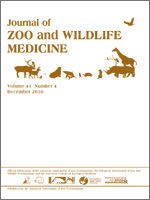The prevalence of gastrointestinal parasites was investigated in mammals housed in two of the main Italian zoological gardens: the Zoo Safari of Fasano (province of Bindisi, Apulia, Italy) and the Giardino Zoologico of Pistoia (Tuscany, Italy). In November 2007, fecal samples were collected at the Zoo Safari of Fasano (n = 96) and at the Giardino Zoologico of Pistoia (n = 60), from primates, carnivores, perissodactyls, artiodactyls and proboscideans. In most of the cases, the same animal species or genera were considered in both the zoos. One or more intestinal parasites were detected in 61.5% of the examined samples. However, very different percentages of protozoa- and helminth-positive samples were obtained in the animals from the two zoos, with an overall gastrointestinal parasitic infection of 77.1% in the Zoo Safari of Fasano and 36.7% in the Giardino Zoologico of Pistoia. Overall, 10% (Cryptosporidium sp.) and 43.3% (Toxocara cati, Strongyloides stercoralis, Toxascaris leonina, and hookworms) of carnivores, 66.7% (Cryptosporidium spp.) and 100% (Trichuris spp. and Strongyloides fülleborni) of primates, 25.0% (Eimeria spp., Cryptosporidium spp.), and 57.1% (Trichuris sp., Toxocara [Neoascaris] vitulorum, gastrointestinal strongyles, and Paramphistomidae) of artiodactyls were infected with protozoa and helminthes parasites, respectively. Only gastrointestinal strongyles were diagnosed in 16.7% of proboscideans and in 50.0% of perissodactyls examined. The results of this study suggest that zoonotic protozoans and gastrointestinal helminths are common in zoo mammals and that these animals may serve as a potential reservoir and transmit these parasites to humans. The different animal management in the two zoos indicates that the regular monitoring of parasitic diseases and the use of selective treatments can represent effective measures for the control of several gastrointestinal infections in zoological gardens.
How to translate text using browser tools
1 December 2010
Gastrointestinal Parasites in Mammals of Two Italian Zoological Gardens
Mariarita Fagiolini,
Riccardo P. Lia,
Piero Laricchiuta,
Paolo Cavicchio,
Riccardo Mannella,
Claudia Cafarchia,
Domenico Otranto,
Riccardo Finotello,
Stefania Perrucci
ACCESS THE FULL ARTICLE
control
gastrointestinal parasites
Italy
zoo mammals
zoonosis





